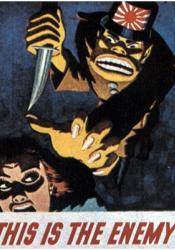WW2 Propaganda: Influence of Racism
In WW2 propaganda was everywhere. It was meant to arouse emotion and in the public eye spread awareness for whichever country’s cause. Propaganda is also a form of manipulation and can cause misconceptions. Misconceptions can lead to stereotypes and during WW2 many stereotypes were formed about Americans, Germans, and Japanese. “This 1942 poster, titled This is the Enemy, circulated in the United States following the Japanese attack on Pearl Harbor. Its purpose was to embody the entire Japanese nation as a ruthless and animalistic enemy that needed to be defeated. This image represents a clash between two nations at war and illustrates the biased perceptions that developed as a result” (Miles). The 1942 poster of the Japanese man dehumanized the people of Japan. As this poster was seen throughout America due to the world war two bombing of Peral Harbor, Americans began to speculate that Japanese were ruthless human beings, which lead to racial hatred; a racial stereotype was formed. This poster was made to strike fear in the hearts of Americans. Paying attention to the art itself, the lines are dark and bold. The lighting accompanied with the outline shows anger from the Japanese man while the other face from the woman shows fear. The poster served its purpose well as it rallied Americans to support the war effort and to bring justice for what happened at Pearl Harbor.
It should also be noted that, “The American audience, young and old alike, could relate to her familiar facial features and human-like appearance. On the other hand, the subhuman depiction of the Japanese detached any human relation between the two races. These racial distinctions were purposefully included in order to further alienate the Japanese as the other people” (Miles). The poster depicted the Japanese man to have a monkey-like or animalistic features while the woman looks perfect. This damaged whatever relations Japan had with the United States further. As propaganda racial defiled the Japanese for the war effort, we can see similar examples today.
After Will Smith assaulted Chris Rock the media went crazy. The Oscars showed the footage which gave everyone at home a front row seat to the action. A few days after the incident, a social media giant, Tik Tok began to release the audio and video from the Oscars onto its platform. Users would use the sound of Will SMith’s voice with images and videos to make jokes. The media today can greatly influence us and as we see from Tik Tok many people reacted differently. However, it leaves a racial stereotype behind. From only showing snippets of the video from the Oscars instead of the full, we see the assault rather than what led up to it. It paints a bad picture for the Black community as some may believe that Will Smith is violent therefore the public opinion will start to fill in the gaps; that Black people can be violent. This is not the case, as the media leaves out information to get certain messages across.
Miles, H. (2012, March). WWII Propaganda: The Influence of Racism. Artifacts Journal // University of Missouri; Artifacts.
https://artifactsjournal.missouri.edu/2012/03/wwii-propaganda-the-influe...

